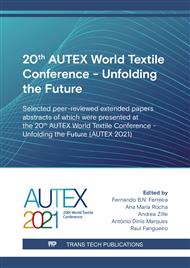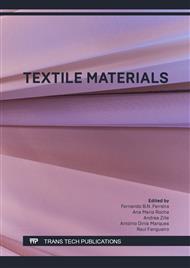[1]
M. Liu et al., Large-Area All-Textile Pressure Sensors for Monitoring Human Motion and Physiological Signals, Adv Mater. 29 (2017) 1–9.
Google Scholar
[2]
C. Guignier, B. Camillieri, M. Schmid, R. M. Rossi, and M. A. Bueno, E-Knitted textile with polymer optical fibers for friction and pressure monitoring in socks, Sensors. 19 (2019) 31–33.
DOI: 10.3390/s19133011
Google Scholar
[3]
J. Deng et al., A tactile sensing textile with bending-independent pressure perception and spatial acuity, Carbon. 149 (2019) 63–70.
DOI: 10.1016/j.carbon.2019.04.019
Google Scholar
[4]
L. Yu et al., Flexible Multi-Material Fibers for Distributed Pressure and Temperature Sensing, Adv. Funct. Mater. 30 (2020) 1-8.
Google Scholar
[5]
M. A. Ali and A. Shavandi, Medical textiles testing and quality assurance, in: Wang, L. (Eds.), Performance Testing of Textiles: Methods, Technology and Applications, Woodhead Publishing, Sawston, 2016, pp.129-153.
DOI: 10.1016/b978-0-08-100570-5.00007-4
Google Scholar
[6]
L. Yue, G. Pircheraghi, S. A. Monemian, and I. Manas-Zloczower, Epoxy composites with carbon nanotubes and graphene nanoplatelets - Dispersion and synergy effects, Carbon. 78 (2014) 268–278, (2014).
DOI: 10.1016/j.carbon.2014.07.003
Google Scholar
[7]
P. Pereira, D. P. Ferreira, J. C. Araújo, A. Ferreira, and R. Fangueiro, The potential of graphene nanoplatelets in the development of smart and multifunctional ecocomposites, Polymers. 12 (2020)2-18.
DOI: 10.3390/polym12102189
Google Scholar
[8]
Y. Wang, W. Dai, Y. Song, D. Wang, L. Zeng, and N. Jiang, Enhanced Thermal and Electrical Properties of Epoxy Composites Reinforced With Graphene Nanoplatelets, Polym. Compos. 16 (2014) 101–113.
DOI: 10.1002/pc.22972
Google Scholar
[9]
C. Chung, M. Lee, and E. K. Choe, Characterization of cotton fabric scouring by FT-IR ATR spectroscopy, Carbohydr. Polym. 58 (2004) 417–420.
DOI: 10.1016/j.carbpol.2004.08.005
Google Scholar
[10]
A. I. Ribeiro et al., Antimocrobial efficacy of low concentration PVP-Silver nanoparticles deposited on DBD plasma-treated polyamide 6, 6 fabric, Coatings. 9 (2019) 1–14.
DOI: 10.3390/coatings9090581
Google Scholar
[11]
W. Raslan, A. El-Halwagy, and H. Elsayad, Recent Advances in Plasma/Nanoparticles Treatments of Textile Fibers, J. Text. Color. Polym. Sci. 17 (2020) 87–105.
DOI: 10.21608/jtcps.2020.33748.1042
Google Scholar
[12]
H. A. Karahan and E. Özdoğan, Improvements of surface functionality of cotton fibers by atmospheric plasma treatment, Fibers Polym. 9 (2008) 21–26.
DOI: 10.1007/s12221-008-0004-6
Google Scholar
[13]
N. V. Bhat, an Netravali, av Gore, mp Sathianarayanan, ga Arolkar, and rr Deshmukh, Surface modification of cotton fabrics using plasma technology, Text. Res. J. 81 (2011) 1014–1026.
DOI: 10.1177/0040517510397574
Google Scholar
[14]
R. Molina, R. Bitar, P. Cools, R. Morent, and N. De Geyter, Effect of liquid impregnation on DBD atmospheric pressure plasma treatment of cotton, Cellulose. 27 (2020) 7847–7859, (2020).
DOI: 10.1007/s10570-020-03306-3
Google Scholar
[15]
P. Nguyen-Tri, F. Altiparmak, N. Nguyen, L. Tuduri, C. M. Ouellet-Plamondon, and R. E. Prud'Homme, Robust Superhydrophobic Cotton Fibers Prepared by Simple Dip-Coating Approach Using Chemical and Plasma-Etching Pretreatments, ACS Omega. 4 (2019) 7829–7837.
DOI: 10.1021/acsomega.9b00688
Google Scholar
[16]
A. Marmur, C. Della Volpe, S. Siboni, A. Amirfazli, and J. W. Drelich, Contact angles and wettability: Towards common and accurate terminology, Surf. Innov. 5 (2017) 3–8.
DOI: 10.1680/jsuin.17.00002
Google Scholar
[17]
J. Wang, Y. Zheng, and A. Wang, Effect of kapok fiber treated with various solvents on oil absorbency, Ind. Crops Prod. 40 (2012) 178–184.
DOI: 10.1016/j.indcrop.2012.03.002
Google Scholar
[18]
S. S. Shazali, S. Rozali, A. Amiri, M. N. M. Zubir, M. F. M. Sabri, and M. Z. Zabri, Evaluation on stability and thermophysical performances of covalently functionalized graphene nanoplatelets with xylitol and citric acid, Mater. Chem. Phys. 212 (2018) 363–371.
DOI: 10.1016/j.matchemphys.2018.03.040
Google Scholar
[19]
J. C. Araújo, D. P. Ferreira, P. Teixeira, and R. Fangueiro, In-situ synthesis of CaO and SiO2 nanoparticles onto jute fabrics: exploring the multifunctionality, Cellulose. vol. 1 (2020) 1123–1138, (2020).
DOI: 10.1007/s10570-020-03564-1
Google Scholar
[20]
M. Bakri and E. Jayamani, Comparative Study Of Functional Groups In Natural Fibers : Fourier Transform Infrared Analysys (FTIR), International Journal of Current Engineering And Sceintific Research. 3 (2016) 154-161.
Google Scholar
[21]
S. M. Costa, D. P. Ferreira, A. Ferreira, F. Vaz, and R. Fangueiro, Multifunctional flax fibres based on the combined effect of silver and zinc oxide (Ag/zno) nanostructures, Nanomaterials. 8 (2018) 1–21, (2018).
DOI: 10.3390/nano8121069
Google Scholar
[22]
S. Naghibi et al., Mortality response of folate receptor-activated , PEG – functionalized TiO 2 nanoparticles for doxorubicin loading with and without ultraviolet irradiation, Ceram. Int. 40 (2014) 5481–5488.
DOI: 10.1016/j.ceramint.2013.10.136
Google Scholar
[23]
S. Luo, Æ. F. Wang, and Æ. Z. Shi, Preparation of highly active photocatalyst anatase TiO 2 by mixed template method, J Sol-Gel Sci Technol. 52 (2009) 1–7.
DOI: 10.1007/s10971-009-2029-8
Google Scholar
[24]
J. Hu, Y. Li, K. Yeung, A. S. W. Wong, and W. Xu, Moisture Management Tester : A Method to Characterize Fabric, Text. Res. J. 75 (2005) 57-62.
DOI: 10.1177/004051750507500111
Google Scholar
[25]
X. Wang, W. Xu, W. Li, and W. Cui, Study on the Electrical Resistance of Textiles under Wet Conditions, Text. Res. J. 79 (2009) 753–760.
DOI: 10.1177/0040517508092018
Google Scholar



